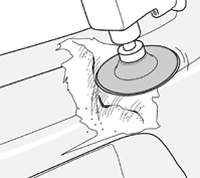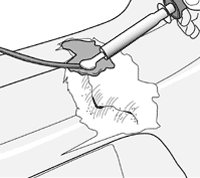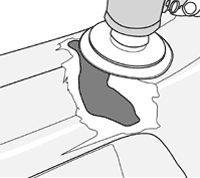We help people repair plastic
Repairing with FiberFlex Universal Rod
FiberFlex Video
FiberFlex is a unique repair material in that it sticks to any plastic substrate. It is not a true welding rod, but rather a thermoplastic or hot-melt adhesive.
When you do a repair with the FiberFlex, you will actually be using the heat of the welder to apply an adhesive. FiberFlex has a very strong bond and is reinforced with carbon and glass fibers for outstanding strength.
FiberFlex is a very popular way to repair TPOs (a.k.a. TEO, PP/EPDM), the most common automotive bumper material. The reason is that there are no two TPOs that are exactly alike. As a result, our R05 series TPO welding rod will not match any TPO exactly.
FiberFlex can also be used to repair virtually any plastic. It will stick to urethanes and Xenoy also. When you are not sure what type of plastic you are repairing, try the FiberFlex.
V-groove Damaged Area
· Line up the outer surface of the tear with 6481 Aluminum Body Tape or with clamps.
· Remove plastic in the shape of a broad V-groove halfway through the backside of the part using a die grinder with either the 6122 Heavy Duty Round Burr or the 6134-R Round Cutter Bit. You'll want the v-groove to be about 1-1/2 inches wide when you get done.
· It is very important to put some "tooth" in the plastic by grinding the v-groove with 50 grit or coarser sandpaper. Use a low speed grinder. Grinding at high speed will tend to melt many thermoplastics.
· Using 80 grit in a DA sander, remove the paint in the area around the v-groove and radius smoothly into the v-groove. This will give you a better featheredge when you get ready to sand the FiberFlex.

Apply FiberFlex
· With the airless plastic welder set to the highest temperature setting, use the 6031 Teardrop-Shaped Tip to melt the R10 FiberFlex welding rod onto the surface. Best adhesion is achieved by premelting one side of the end of the rod, then flipping the rod over so that the melted portion sticks to the plastic. Cut the melted part of the ribbon off using the edge of the welder tip and spread the FiberFlex into the v-groove. Do not attempt to melt the base material together with the FiberFlex. Repairing with Fiber-Flex is similar to a brazing process.

V-Groove and Weld Opposite Side
After the FiberFlex cools on the backside (you may force cool with water), repeat the v-grooving and welding process on the opposite side. Build the FiberFlex slightly higher than the surface. FiberFlex is also a sandable filler.

Finish Sand
· After allowing the FiberFlex to cool completely, sand with 80 grit paper in a DA sander at low speed. Progress to finer grits, ending with 320 grit.
· Fill any low spots with more FiberFlex or with a skim coat of 2000 Flex Filler or 2020 Hardset Filler.
hdpe welding wire polyvance repair kit plastic welding company nylon welding rod plastic repairs
Product Suggestions

